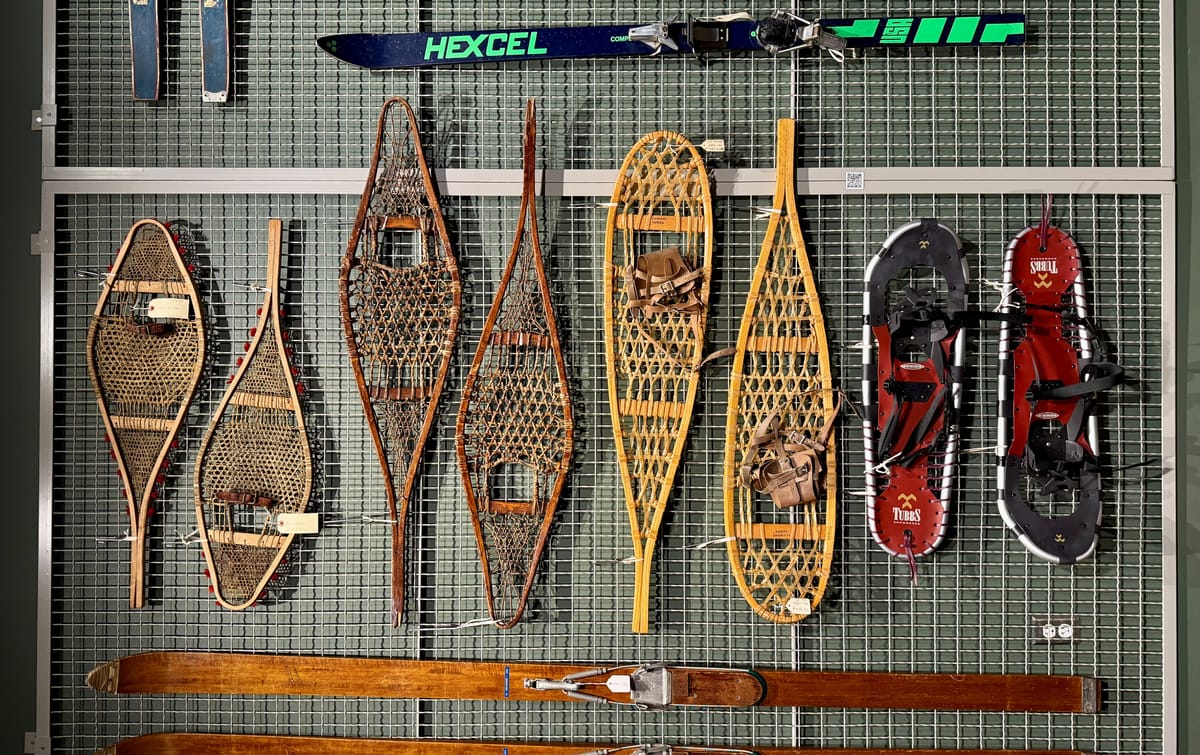Evolution of the snowshoe
Sometimes, the oldest tools still work just as well as they did hundreds of years ago

This past weekend’s snowstorms left Vermont covered in a nice, thick layer of snow. After clearing our driveways and footpaths, it’s an excellent time to get outdoors for some recreation time. Vermonters have dealt with the snow for hundreds of years, and looking through the Vermont Historical Society’s object collection is a good way to see how one particular tool has changed with time – and remained largely the same: the snowshoe.
Snowshoes have been used for thousands of years across the world. In a paper published in 1911 in The Museum Journal, scholars noted that the snowshoe was a widespread tool amongst the tribes of North America. It had a basic form: a frame, usually made of wood, bone, or antler, with a web of hide stretched across it. The frame would distribute the wearer’s weight, allowing them to walk on – or at least not sink into – the snow.
In his journals chronicling his expeditions, Samuel de Champlain recounted seeing Native Americans use snowshoes during the winter months in the early 1600s: “In the winter when the Snowes are great they make a kinde of racket which is twice or thrice as bigge as one of ours in France, which they fasten to their feete, and so goe on the Snow without sinking.”

In the years that followed, the European colonists who began settling in the forests of North America adopted snowshoes for their own uses.
VHS counts a number of snowshoes in its collection, and that basic form remains largely unchanged. The oldest set is #L2024.3.159a-b, a pair of square-toed snowshoes with rawhide (damaged) weaving. These recently arrived to our collection from the Abenaki Cultural Conservancy and are estimated to date back to around 1880. They were handed down within a Missisquoi Abenaki family from Stanbridge, Quebec. Another set (#L2024.3.160a-b) from around the same period are described as “Abenaki-style snowshoes” and feature pointed, rather than squared tips.

Moving into the 20th century, the general form remained the same: rawhide stretched across a wooden frame: one set dates back to around 1900 (#1974.8.2a-b), another from 1918 (#2014.2a-b), used by a Theron Skidmore Dean while he worked along the Long Trail, while another (#L2024.3.158a-b) is described as being made by an Abenaki family in Fonda Junction (Swanton) in the 1950s.
While snowshoes were made by craftspeople for centuries, the growing field of outdoor recreation saw the arrival of dedicated manufacturers at the turn of the century. Tubbs Snowshoes was founded in 1906 in Norway, Maine, manufacturing a variety of snowshoes from traditional materials, such as ash wood and rawhide. According to an article in Sports Illustrated published in 1979, the company was eventually relocated to Vermont, where it made snowshoes for outdoorsmen and the US Army.

When the business changed hands in 1968, it continued to churn out snowshoes for a new generation of enthusiasts (item #1974.38a-b is such a pair, “Cross Country, 10 x 46”, made sometime around 1970) , and began making some updates to the as-of-then-unchanged form: it began introducing new materials like neoprene. Other updates included light aluminum frames and plastic bindings, represented by in our collection by #1996.37a-b. Tubbs relocated from Wallingford to Stowe and in 2003, the company was sold to another firm, K2 Inc., which moved its manufacturing operations to China the following year. Tubbs wasn’t the only company making snowshoes in Vermont: another, Dion-NeviTrek, manufactures its snowshoes in Pownal.
Tubbs and its advances didn’t completely replace the traditional snowshoe. Item #2005.18a-b (once used by former VHS Executive Director Michael Sherman!) was made in the workshop of Armand and Marie Boutin of Williamstown out of traditional materials: ash and rawhide. Sometimes, those time-tested methods still work as well as they did hundreds of years ago.